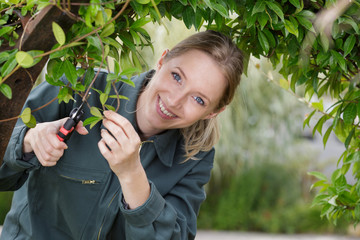Tree pruning is a necessary part of tree care. Trees of various sizes have different needs, and it is essential to follow certain principles to get the best results. When pruning a tree, it is important to avoid tearing the bark and to use the correct technique. It is best to use a handsaw rather than a chainsaw to avoid damage. Also, it is best to avoid coating the pruning cuts, as this will prevent the wound from healing properly.

Tree pruning helps maintain the shape of a tree, and it is also necessary for safety. The wrong way to prune a tree can damage the structure and reduce its life. Dead or broken branches can fall, blocking a driver’s vision. Another danger comes when a tree grows too close to utility lines and structures.
Tree pruning should start with identifying where the branches will be cut. On the diagram, the branches that will be cut are indicated in blue. Similarly, cuts made on the red lines should only cut branch tissue. This prevents the formation of unwanted suckers and water sprouts. In addition, the procedure will improve the wound seal.
The second step is crown reduction, which is usually done to mature trees. This method involves removing specific branches, and is necessary for reducing the overall density of a tree. It also helps increase air circulation and sunlight penetration, and reduces stress on the limbs. It is best to prune branches that are at least one third of the diameter of the stem, and angle them away from the stem. In addition, dead branches should be pruned in the same manner as live branches.
Tree pruning can be done by either a professional arborist or by a tree care company. Whether you’re doing the job yourself or hiring a tree care company, you should be sure to follow the National Standards Institute guidelines when pruning your tree. After all, trees need to be healthy to grow properly and have a strong canopy.
Thinning the crown is the most common form of pruning on mature trees. It involves cutting certain live branches from a tree’s crown in order to reduce the overall density. This is a necessary step for improving sunlight and air circulation, while decreasing the stress on selected limbs. However, this method should be carried out only when the tree’s leaves have fully developed.
Reduced error pruning is another approach to pruning. It starts at the lowest point of a tree and removes relevant nodes, while avoiding sub-trees. Its advantage is its simplicity and speed. The goal of reduced error pruning is to remove the most irrelevant nodes, without losing the most relevant ones.
It is important to prune trees in accordance with the seasons. Different species will respond to pruning in different seasons. The best time for pruning is late winter or early spring. This is because wounds heal more quickly if the cut occurs before the bud break. Also, when pruning flowering trees, avoid pruning the flower buds. Some trees form flower buds on old wood, while others form them on new wood.
There are many reasons to prune a tree. Proper pruning will help maintain the health and aesthetics of a tree. It will increase the amount of light and air that passes through a tree. It will also increase air circulation and reduce the weight on the larger limbs. Pruning can also help preserve the shape of a tree.
While it may seem difficult, tree pruning is essential for a healthy tree. Proper trimming will remove diseased, loose, and dead branches, promote strong growth, and protect it from insects and diseases. However, if you are not familiar with this procedure, it is best to consult an arborist. It is important to use the right techniques and equipment.
Tree pruning can be done using loppers, chainsaws, or hand pruners. Arborists may use a saw for larger trees. But most trimming is done with manual, electric, or gas-powered clippers. It is important to avoid improper pruning practices like topping and buckling.
When pruning a tree, the process of pruning changes the structure of the model. The pruned nodes are now regarded as leaf nodes. Decision trees are made up of a root node, branch nodes, and leaf nodes. The root node represents the top of the tree, while the branch nodes represent the middle. Branch nodes contain several child nodes. The leaf nodes, on the other hand, are the lowest branches of the tree.
